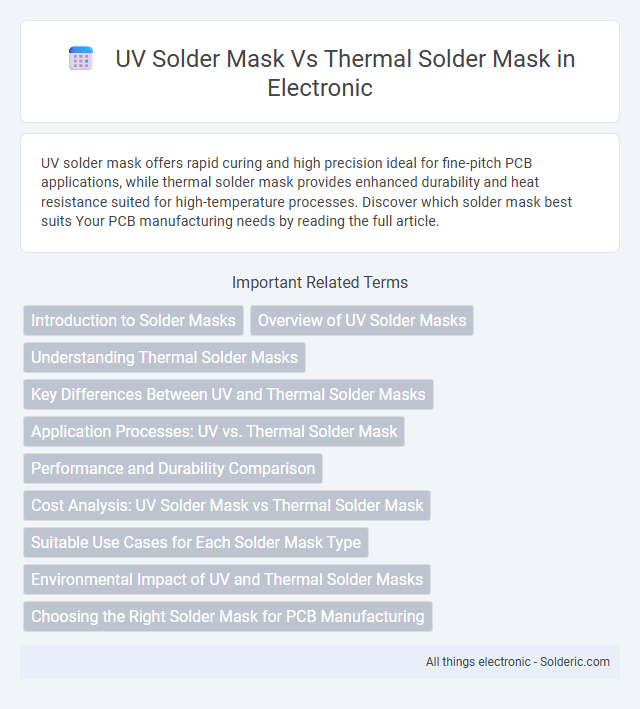UV solder mask offers rapid curing and high precision ideal for fine-pitch PCB applications, while thermal solder mask provides enhanced durability and heat resistance suited for high-temperature processes. Discover which solder mask best suits Your PCB manufacturing needs by reading the full article.
Comparison Table
| Feature | UV Solder Mask | Thermal Solder Mask |
|---|---|---|
| Curing Method | Ultraviolet (UV) light exposure | Heat (thermal) curing |
| Curing Time | Seconds to minutes | Several minutes to hours |
| Temperature Range | Room temperature during curing | High temperature required (usually 100-200degC) |
| Process Complexity | Simple, fast processing | Requires ovens or thermal equipment |
| Application | Mass production, rapid prototyping | High reliability, high-temperature environments |
| Mask Durability | Good chemical and mechanical resistance | Superior thermal and mechanical stability |
| Environmental Impact | Less energy consumption | Higher energy use due to heating |
| Cost | Generally lower cost | Higher cost due to equipment and energy |
Introduction to Solder Masks
Solder masks serve as protective coatings applied to printed circuit boards (PCBs) to prevent oxidation and solder bridging during assembly. UV solder masks cure through exposure to ultraviolet light, offering rapid processing and high resolution, while thermal solder masks rely on heat for curing, providing robust adhesion and durability. Your choice between UV and thermal solder masks impacts manufacturing speed, precision, and the overall reliability of the PCB.
Overview of UV Solder Masks
UV solder masks utilize ultraviolet light to cure and harden the protective layer applied on printed circuit boards, ensuring precise pattern definition and high-resolution masking. These masks offer faster curing times compared to thermal solder masks, enhancing production efficiency in PCB manufacturing. UV solder masks provide superior adhesion and chemical resistance, making them ideal for advanced electronics requiring detailed circuitry protection.
Understanding Thermal Solder Masks
Thermal solder masks offer enhanced heat resistance compared to UV solder masks, making them ideal for applications involving high-temperature soldering processes like reflow or wave soldering. These masks provide superior insulation and prevent solder bridging while maintaining mechanical durability under thermal stress. Understanding thermal solder masks helps ensure your PCB assemblies retain reliability and performance in demanding thermal environments.
Key Differences Between UV and Thermal Solder Masks
UV solder masks harden through ultraviolet light exposure, enabling rapid curing with high precision on printed circuit boards (PCBs). Thermal solder masks cure using heat, requiring elevated temperatures and longer processing times, which can affect substrate materials sensitive to heat. The key difference lies in the curing mechanism, where UV offers faster processing and improved resolution, while thermal provides enhanced durability and chemical resistance for high-temperature applications.
Application Processes: UV vs. Thermal Solder Mask
UV solder masks cure through exposure to ultraviolet light, enabling rapid hardening and precise patterning ideal for fine-pitch components on PCBs. Thermal solder masks rely on heat-activated curing processes, requiring controlled oven temperatures to achieve optimal adhesion and durability. The UV process offers faster throughput and selective curing, while thermal methods provide uniform coverage with enhanced thermal stability for high-temperature applications.
Performance and Durability Comparison
UV solder masks offer superior chemical resistance and faster curing times, making them ideal for high-volume production environments. Thermal solder masks provide enhanced thermal stability and greater mechanical strength, improving durability under extreme temperature fluctuations. Both types ensure reliable PCB protection, but UV masks excel in precision and speed, while thermal masks deliver long-term resilience and structural integrity.
Cost Analysis: UV Solder Mask vs Thermal Solder Mask
UV solder mask generally offers lower initial costs due to faster curing times and simplified processing equipment, making it suitable for high-volume PCB production. Thermal solder mask requires higher energy consumption and specialized curing ovens, increasing operational expenses despite its superior thermal resistance and durability. Cost analysis favors UV solder mask for budget-sensitive projects, while thermal solder mask's higher upfront cost may be justified by enhanced performance in demanding applications.
Suitable Use Cases for Each Solder Mask Type
UV solder masks are ideal for high-precision electronics requiring rapid curing and fine feature definition, commonly used in consumer electronics and complex PCB assemblies. Thermal solder masks excel in applications demanding superior thermal resistance and durability, making them suitable for high-power devices, automotive electronics, and harsh environment circuits. Selecting the appropriate solder mask depends on the operational environment and performance requirements of the PCB.
Environmental Impact of UV and Thermal Solder Masks
UV solder masks typically have a lower environmental impact due to their reduced energy consumption during curing and minimal volatile organic compound (VOC) emissions compared to thermal solder masks, which require high temperatures and prolonged heating. The UV curing process emits fewer greenhouse gases and generates less hazardous waste, contributing to more sustainable manufacturing practices. However, proper disposal and recycling of UV resin materials remain essential to minimizing ecological risks associated with their use.
Choosing the Right Solder Mask for PCB Manufacturing
Selecting the right solder mask for PCB manufacturing impacts durability and performance, with UV solder masks offering rapid curing and excellent chemical resistance, ideal for high-volume production. Thermal solder masks provide superior heat resistance and mechanical strength, making them suitable for applications exposed to elevated temperatures. Your choice depends on production scale, environmental conditions, and specific electronic requirements.
UV solder mask vs thermal solder mask Infographic

 solderic.com
solderic.com